| Click on a picture to enlarge | The pictures you see after clicking on the small thumbnail
pictures, are shrunk to 5% of their original dimensions If you like to see a picture in full glory, send an email! |
| NEXT Story | PREVIOUS Story |
| For pictures click here | Back to Homepage | \
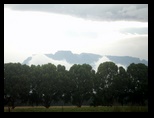 as she often plays a DVD about Draakje, a dragon. Upon approaching the mountains, she said to us: you should not be afraid of the dragons, as I will protect you. But as we came closer no Drakensberg was to be seen as the mountains were shrouded in clouds.
as she often plays a DVD about Draakje, a dragon. Upon approaching the mountains, she said to us: you should not be afraid of the dragons, as I will protect you. But as we came closer no Drakensberg was to be seen as the mountains were shrouded in clouds. 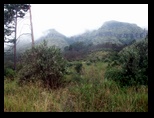 Due to the high altitude it was rather cool.
Due to the high altitude it was rather cool. 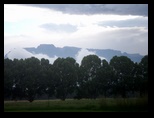 We made a trip to the Drakensbergen national Park
We made a trip to the Drakensbergen national Park  but when we wished to walk there, it was raining,
but when we wished to walk there, it was raining, 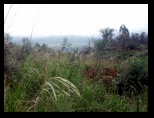 so we decided to cancel the walk and proceeded back to the mud road leading to Ardmore. Enroute we saw the mountains covered with clouds and under the clouds there was a view over the valleys. On the mud road to Ardmore we saw many kniphopfia’s
so we decided to cancel the walk and proceeded back to the mud road leading to Ardmore. Enroute we saw the mountains covered with clouds and under the clouds there was a view over the valleys. On the mud road to Ardmore we saw many kniphopfia’s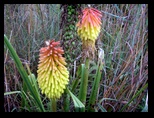 (kniphofia linearfolia) in the wild growing. And by the red mud, our white car was red again.
(kniphofia linearfolia) in the wild growing. And by the red mud, our white car was red again.
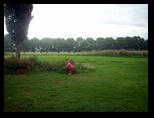 The owner, Paul Ross offered free Wi-Fi access, and as it was recently installed, we could check if it did live up to the specifications if the installer. It did not and the installer came to upgrade it. Paul was dependent for his website www.ardmore.co.za on a local IT expert and he was not too happy with it. Any maintenance does cost a lot. Talking about it he liked additionally a website that he could manage himself and I proposed him to lock in a good name and to start a website himself. We got the domain www.drakensberg-southafrica.com with a discount and worked on a homepage which was initially a clone of my homepage, but of course tailored for his use. The extra features like the free web shop software could be highly useful for his wife Sue to put the artistic products of the local craftsmen and women on the market. Next to the Ardmore Guest Farm is the African Loom weaving business ( www.africanloom.com )and the Ardmore Ceramic Art Studio. If the market could be expanded by Internet, it would be great for the hard working people there.
The owner, Paul Ross offered free Wi-Fi access, and as it was recently installed, we could check if it did live up to the specifications if the installer. It did not and the installer came to upgrade it. Paul was dependent for his website www.ardmore.co.za on a local IT expert and he was not too happy with it. Any maintenance does cost a lot. Talking about it he liked additionally a website that he could manage himself and I proposed him to lock in a good name and to start a website himself. We got the domain www.drakensberg-southafrica.com with a discount and worked on a homepage which was initially a clone of my homepage, but of course tailored for his use. The extra features like the free web shop software could be highly useful for his wife Sue to put the artistic products of the local craftsmen and women on the market. Next to the Ardmore Guest Farm is the African Loom weaving business ( www.africanloom.com )and the Ardmore Ceramic Art Studio. If the market could be expanded by Internet, it would be great for the hard working people there.
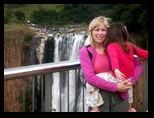 at Howick,
at Howick, 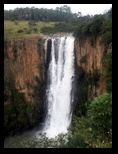 they fall more than 100 meter. At the underside a jet of mist is expelled by the force of the thundering water.
they fall more than 100 meter. At the underside a jet of mist is expelled by the force of the thundering water.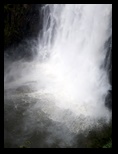
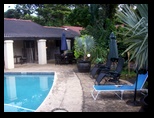 and very close to the beach. Our Host enjoys the nice weather here, he said.
and very close to the beach. Our Host enjoys the nice weather here, he said.
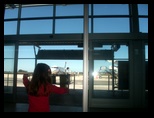 They fly about 8 times per day this trip and claim they have the world’s best on-time departure record, and indeed that flight was accurate on schedule.
They fly about 8 times per day this trip and claim they have the world’s best on-time departure record, and indeed that flight was accurate on schedule.
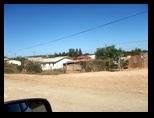 There is only one bigger building: the police station. In general the people are friendly, well fed and with normal clothes. Only the housing is in a big contrast to that.
There is only one bigger building: the police station. In general the people are friendly, well fed and with normal clothes. Only the housing is in a big contrast to that.
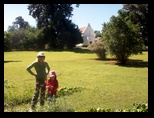 and lush garden, it is a paradise. We had a roomy 3 room apartment, nice and cool in the hot weather.
and lush garden, it is a paradise. We had a roomy 3 room apartment, nice and cool in the hot weather. 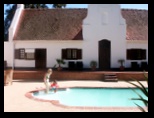 In this area the nights are cool, which is better for night rest. The weather was brilliant, blue sky and a comfortable temperature in the higher twenties.
In this area the nights are cool, which is better for night rest. The weather was brilliant, blue sky and a comfortable temperature in the higher twenties.
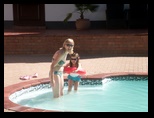 so this time we went to dinner in a restaurant and Mariska as usual did not like to eat anything from the restaurant food but ice cream.
so this time we went to dinner in a restaurant and Mariska as usual did not like to eat anything from the restaurant food but ice cream.
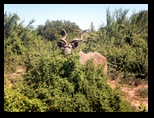 Red hartebeest
Red hartebeest 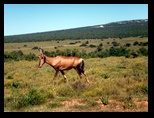 and many more.
and many more.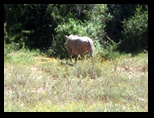 One interesting observation was a giant varan, moving like a small crocodile. Further we saw lots of turtles,
One interesting observation was a giant varan, moving like a small crocodile. Further we saw lots of turtles, 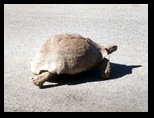 (leopard tortoises), and smaller stuff. We spend all day there and especially Mariska enjoyed the
(leopard tortoises), and smaller stuff. We spend all day there and especially Mariska enjoyed the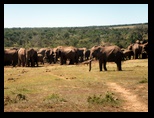 elephants
elephants
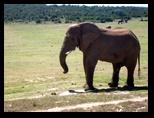
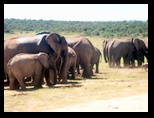
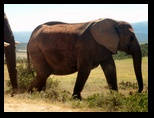
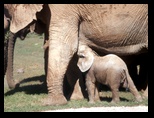
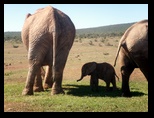 and other animals
and other animals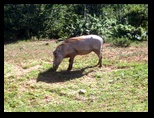 .
For many more pictures look here
All around in the park was blooming the plumbago plant,
.
For many more pictures look here
All around in the park was blooming the plumbago plant, 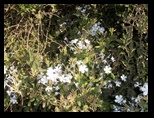 all pale blue and rich flowering.
all pale blue and rich flowering.
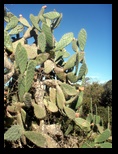 and other succulents. People go to South Africa for the Big Five animals, but there are far more interesting wild flowers. And they do not run away if you like to make a picture. Especially a type plant was blooming with a deep red-yellow color was eye catching. It is the Aloe ferox,
and other succulents. People go to South Africa for the Big Five animals, but there are far more interesting wild flowers. And they do not run away if you like to make a picture. Especially a type plant was blooming with a deep red-yellow color was eye catching. It is the Aloe ferox, 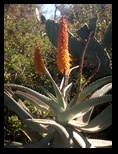 with an intense bitter juice, used in pharmaceutical industry. The cactuses have this time of the year lots of juicy fruit. Especially interesting are the sanseveria,
with an intense bitter juice, used in pharmaceutical industry. The cactuses have this time of the year lots of juicy fruit. Especially interesting are the sanseveria, a beloved classical plant on the window shelf. There were other beautiful plants
a beloved classical plant on the window shelf. There were other beautiful plants 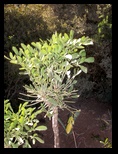 that could be beloved plants in the house. In this area the roads were lined with protea’s the big,
that could be beloved plants in the house. In this area the roads were lined with protea’s the big,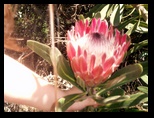 national flower of South Africa. Mariska shows much interest in these.
national flower of South Africa. Mariska shows much interest in these. 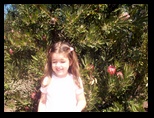
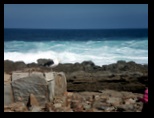 . OK, it’s nice but there are many more nice area’s, most even free.
The waves broke against the rock, making it a foamy sea water.
The area was nice indeed and impressive forests, mainly of milkwood, ironwood, stinkwood and yellowwood, all prized timber, were dominant. The walk we made led to a suspension bridge
. OK, it’s nice but there are many more nice area’s, most even free.
The waves broke against the rock, making it a foamy sea water.
The area was nice indeed and impressive forests, mainly of milkwood, ironwood, stinkwood and yellowwood, all prized timber, were dominant. The walk we made led to a suspension bridge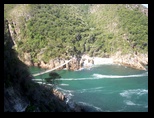 . We had nice view to the coast. Mariska ventured over the steep stairs, that gave a nice view in the fjord,
. We had nice view to the coast. Mariska ventured over the steep stairs, that gave a nice view in the fjord,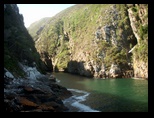 and to the sea
and to the sea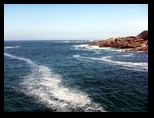 . An older couple made remarks about Mariska, who was without fear enjoying the unstable swinging bridge
. An older couple made remarks about Mariska, who was without fear enjoying the unstable swinging bridge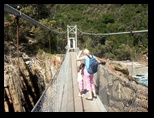 . The steep stairs up was not a problem either.
. The steep stairs up was not a problem either.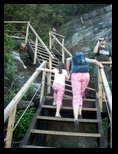 The milkwood trees
The milkwood trees 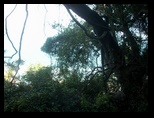 were dominant here. This area was full of meters thick trees, but from 1860 -1890 the woodcutters succeeded in cutting almost all the giant trees, leaving a desolate area. Only in the difficult accessible area’s like here in Tsitsikama, some trees remained. Wherever you come in the world, USA, New Zealand, Australia, everywhere you notice the same sad story. Now the trees of the yellowwood are all protected.
were dominant here. This area was full of meters thick trees, but from 1860 -1890 the woodcutters succeeded in cutting almost all the giant trees, leaving a desolate area. Only in the difficult accessible area’s like here in Tsitsikama, some trees remained. Wherever you come in the world, USA, New Zealand, Australia, everywhere you notice the same sad story. Now the trees of the yellowwood are all protected.
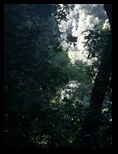
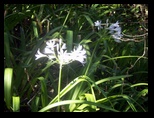 is here endemic, be it that in the forest it is more fragile. In fact many of the prized garden plants in Europe are just originating in South Africa.
is here endemic, be it that in the forest it is more fragile. In fact many of the prized garden plants in Europe are just originating in South Africa.
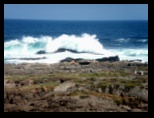
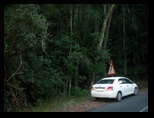 of the stunning nature in the ravine, we indeed saw part of the road was gone.
of the stunning nature in the ravine, we indeed saw part of the road was gone. 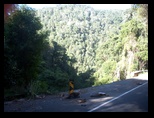 And further again.
And further again. 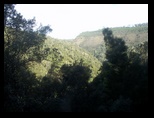 The sandstone was not stable enough to support a road. It will cost some time till this problem is fixed, but for now we enjoyed the route which was as least as nice as the Tsitsikama area.
The sandstone was not stable enough to support a road. It will cost some time till this problem is fixed, but for now we enjoyed the route which was as least as nice as the Tsitsikama area.
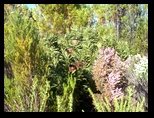 in various kinds. And many more flowers
in various kinds. And many more flowers 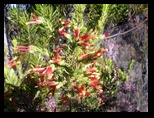 with magic colors
After so many days in the nature we decided to have a city day in Knysna. A stroll along the waterfront
with magic colors
After so many days in the nature we decided to have a city day in Knysna. A stroll along the waterfront 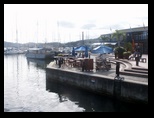 with many shops, ships
with many shops, ships 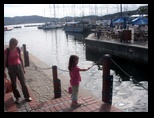 and restaurants and relaxing in the pool. The weather was wonderful and we enjoyed Knysna
and restaurants and relaxing in the pool. The weather was wonderful and we enjoyed Knysna 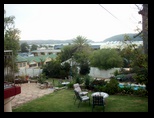 . Next day we planned to travel to Oudshoorn.
. Next day we planned to travel to Oudshoorn.
| Click on a picture to enlarge | The pictures you see after clicking on the small thumbnail
pictures, are shrunk to 5% of their original dimensions If you like to see a picture in full glory, send an email! |
| NEXT Story | PREVIOUS Story |
| For pictures click here | Back to Homepage | \